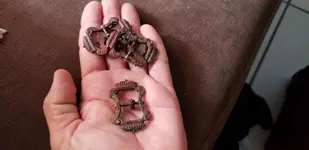No, for the reasons already stated above.
OK Alex, I believe these are your "reasons stated above":
1) As far as I know, there are NO copper alloyed fasteners ever been archaeologically comproved on modern sites dating to prior the 1770s.
2) There are no copper alloyed fasteners listed on construction bills for Spanish ships prior to early 1800s, only "clavos de hierro" - and believe me, I have read hundreds.
3) The Spanish had lots of iron ore in the Basque country. Iron was cheap and readily available for them.
4) Bronze, however, was really expensive, as they hardly had tin and they were always scrapping for it for artillery.
5) So, economically and logistically, it did not make sense to have copper alloyed ship fasteners instead of iron ones.
Reason 1 - "as far as I know"
Many thousands of ships were constructed between 1500 and 1770 and your sample is rather small.
Reason 2 - "... no copper alloyed fasteners listed on construction bills..." [that you have examined]
See above and, as I posted previously, in the new world copper was more plentiful than iron - iron nails and fittings had to be imported from Spain - and copper and bronze were used to produce all manner of useful items. Let me re-post the quote:
"The history of commercial mining in Mexico dates back to the Colonial Period. Because of its use in
many critical sectors of the economy, copper was a significant resource in New Spain. In a society where
iron goods were scarce, copper (unalloyed or mixed with tin or zinc to produce bronze or brass) was
indispensable. It was the most widely employed utilitarian metal in Spanish Colonial times. Its importance
is manifest in the many ways it was used, from coinage and armaments to innumerable articles of industrial,
domestic, and artistic use. In its nonmetallic form, it was used to process silver ore. In the eyes of the crown,
the use of copper for making silver and gold coins and armaments commanded the highest priority followed
by its use for making utensils and equipment needed in the manufacture of sugar (Barrett, 1987)."
Reasons 3, 4, and 5 - see above. You are generalizing and making assumptions and assertions that are not necessarily generalize-able.
Iron nails are ancient, no doubt:
The history of nail making
and used in shipbuilding as the construction bills attest:
https://www.qaronline.org/conservation/artifacts/structural-components/iron-nails-and-spikes
but the use of iron structural elements was hampered by the poor quality of wrought iron prior to the 18th century. Uses of iron in direct contact with seawater seem to be mainly for anchors and rudder fittings before then. The latter was one of the main problems with lead sheathing as it caused the rudder fittings to deteriorate. Lead sheathing was afixed with copper nails. Wood sheathing with treenails - and perhaps bronze or copper spikes, especially I would think for repairs. There would be many uses for iron nails and bolts in the interior of the ship and for various fittings where no direct or prolonged contact with seawater would be expected, and by volume this would be the great majority of such items used for construction.
Shipbuilding, 1590-1790 by Y. Eyup Ozveren [Source: Review (Fernand Braudel Center) , 2000, Vol. 23, No. 1, Commodity Chains in
the World-Economy, 1590—1790 (2000), pp. 15-86] has a shipbuilding commodities chain chart on page 16 listing copper and bronze for various uses, along with iron. It mentions that Havana was a major center of Spanish shipbuilding during the 17th century as well as a port on the west coast of Nicaragua. We know that repairs were commonly performed at Vera Cruz.
This link talks about a 17th century ship's galley lined with copper as fire proofing:
https://maritimeasia.ws/maritimelanka/avondster/galley.html
This article talks about ship construction in some detail and may be of interest to some:
THE STRUCTURES OF ENGLISH WOODEN SHIPS:
WILLIAM SUTHERLAND'S SHIP, CIRCA 1710
Trevor Kenchington, The Northern Mariner/Le Marin du nord, III, No. 1 (January 1993),l-43.
[I have this and the one cited above as pdf's if someone cannot access the Springer online version]
The long and the short here is that statements that no bronze or copper fasteners were used prior to 1770, except in pre-Roman times seems... fantastical, actually. More likely they were used where appropriate by choice and perhaps where a fastener was needed in a pinch if that was what was available and that the bulk of the fasteners on any given ship of the period were iron - for the reasons you suggest and throughout the interior of the ship because corrosion resistance is less of a factor.







